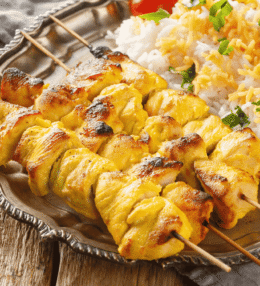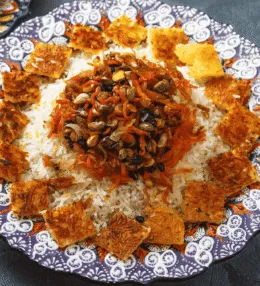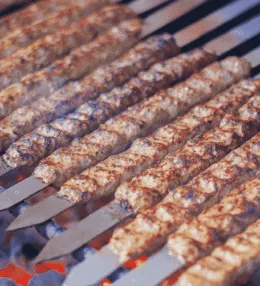
- View
Table of Contents
ToggleIn Croatia, few sights announce a feast quite like a lamb slowly roasting on a spit over glowing embers. Picture a young lamb slowly turning above embers while rosemary needles crackle below. Olive wood smoke drifts across a courtyard, and the cook keeps a steady pace, brushing the skin so it turns burnished and crisp while the meat stays succulent.
It is the dish families choose when everyone is coming home. Weddings, saint days, and big summer gatherings often centre on this roast. People linger, talk, and pick at the first slices while the rest keeps turning, a reminder that good food can also be a gentle ceremony.
The appeal lies in balance. The exterior shatters with a delicate crunch, the interior is tender and fragrant, and every slice carries a lick of fire and herb. Plates usually hold simple sides such as bread, salad, or potatoes, letting the lamb’s character lead the meal.
Want to dive deeper into Croatian Cuisine? Don’t miss our post on Traditional Croatian Foods to Try
What Is Janjetina na Ražnju?
Janjetina na Ražnju means lamb on the spit, cooked whole over a live fire. A slender rod runs through the carcass, so it rotates evenly. The fire is kept low and steady, and the lamb turns for hours. The rhythm matters as much as the heat, giving time for fat to baste the meat.
Basting is done with a rosemary brush dipped in olive oil, sometimes mixed with wine or a squeeze of lemon. Garlic may be rubbed along the skin, and coarse sea salt is added little by little. Nothing heavy is used, since the goal is clear flavour rather than strong marinade.
Once the skin is deeply golden, the lamb is rested and carved in generous pieces. Ribs and shoulder please those who like richer bites, while the leg brings clean slices. Everything tastes of the fire. A plate of lettuce and onions offers freshness beside the savoury meat.
Ingredients and Taste
The ingredient list is modest. Young lamb, sea salt, garlic, rosemary, bay, and good olive oil do the work. Some cooks add lemon zest for brightness. The fuel is part of the recipe too, with olive, vine, or beech wood giving different shades of smoke and warmth.
Texture sets this roast apart. The skin dries as it turns, then crackles at the bite. The meat stays juicy because the slow spin spreads the fat. Flavour reads clean and herbal at first, then gently sweet from the lamb, with a whisper of smoke that lingers without heaviness.
Typical accompaniments are equally direct. Dalmatian style chard and potatoes bring earthiness. Bread mops up the juices. A simple green salad clears the palate, and a glass of local wine such as Plavac Mali or Pošip fits the mood without pulling attention away.
A Taste of History
The custom grew from pastoral life on the Adriatic islands and the karst inland. Flocks grazed on wild sage and rock herbs, which shaped the flavour of the meat. Spit roasting suited outdoor work and large families, and it turned a slaughter day into a shared occasion.
Through centuries of trade and travel, the method stayed steady. Illyrian, Roman, Venetian, and Ottoman eras left their marks on towns, yet the courtyard roast remained much the same. Fire, patience, and a few herbs still define the craft from Pag to Brač and beyond.
Today you will see lamb turning in village squares and at roadside grills when festivals come around. Restaurants serve it too, but the spirit is still communal. People gather, carve, pass plates, and tell stories, letting the evening stretch as the embers glow.
How to Make Janjetina na Ražnju
Janjetina na Ražnju is a Croatian classic prepared for feasts and gatherings, where whole lamb is slowly roasted on a spit over open fire. Expect juicy, tender meat with a crisp golden skin flavoured simply with herbs and garlic. The process is slow, rewarding, and deeply tied to tradition. See the recipe card at the bottom for printable directions
Ingredients
For the lamb
- 1 young lamb (approx. 6–7 kg, butchered for roasting, serves 4 generously with leftovers)
- 5 garlic cloves, sliced thinly
- 3 tbsp lard or olive oil
- 2 tbsp coarse sea salt
- 1 tbsp freshly ground black pepper
- 2 tbsp fresh rosemary, chopped
- 2 tbsp fresh thyme, chopped
- Juice of 2 lemons
For basting
- 150 ml olive oil
- 150 ml white wine
- 3 garlic cloves, crushed
- 1 sprig rosemary
For serving
- Rustic bread
- Fresh salad or grilled vegetables
Cooking Instructions
Step 1: Prepare the lamb
To begin, clean the lamb thoroughly and pat it dry. Use a sharp knife to make small incisions across the meat, then insert garlic slices into each cut. This allows flavour to penetrate. Transition to seasoning.
Step 2: Season generously
Rub the lamb inside and out with salt, pepper, rosemary, thyme, lemon juice, and softened lard or olive oil. Massage well into the skin and cavity. Rest the lamb for at least 1 hour at room temperature. Move on to preparing the spit.
Step 3: Mount the lamb on the spit
Secure the lamb firmly onto the spit rod with clamps or wire. Ensure it is balanced to allow even rotation during roasting. Prepare your fire while the lamb rests.
Step 4: Prepare the fire
Build a wood fire, ideally with hardwood such as beech or oak, and allow it to burn down to glowing embers. Avoid large flames as they can char the lamb too quickly. Once embers form, move to roasting.
Step 5: Start slow roasting
Place the spit over the embers and begin turning slowly and consistently. Roast for about 3–4 hours, depending on lamb size. Keep the fire steady by adding wood gradually. Transition to basting.
Step 6: Prepare the basting mixture
In a small pan, gently warm olive oil, white wine, crushed garlic, and rosemary. This aromatic mixture will be used throughout roasting to keep the lamb moist. Move to basting.
Step 7: Baste regularly
Every 20–30 minutes, brush the lamb generously with the basting mixture. This enhances flavour, adds shine to the skin, and prevents drying. Continue rotating evenly during the process.
Step 8: Check for doneness
Pierce the thickest part of the leg with a skewer. The juices should run clear, and the skin should be evenly golden and crisp. Internal temperature should be about 75°C. Prepare for resting.
Step 9: Rest the lamb
Once cooked, carefully remove the lamb from the spit. Let it rest, loosely covered, for 15 minutes to allow juices to redistribute before carving. Transition to serving.
Final Step: Serve and enjoy
Carve the lamb into portions and serve with rustic bread, fresh salad, or grilled vegetables. Presentation tip: drizzle with a little of the warm basting mixture before serving to highlight its aroma and sheen.
Variations and Substitutions
- If whole lamb is not available, use a lamb shoulder or leg roasted in the oven at 160°C for 3 hours, basting frequently.
- Substitute lard with ghee for similar richness if preferred.
- If hardwood is unavailable, use charcoal with a few soaked wood chips for smoke flavour.
Cooking Tips for Perfect Janjetina na Ražnju
- Choose a young lamb for tender meat and delicate flavour.
- Keep the fire low and steady with glowing embers rather than high flames.
- Balance the lamb well on the spit to ensure even rotation and cooking.
- Always allow resting time before carving for the juiciest results.

Janjetina na Ražnju (Spit Roasted Lamb)
Ingredients
For the lamb
- 1 young lamb approx. 6–7 kg, butchered for roasting, serves 4 generously with leftovers
- 5 garlic cloves sliced thinly
- 3 tbsp lard or olive oil
- 2 tbsp coarse sea salt
- 1 tbsp freshly ground black pepper
- 2 tbsp fresh rosemary chopped
- 2 tbsp fresh thyme chopped
- Juice of 2 lemons
For basting
- 150 ml olive oil
- 150 ml white wine
- 3 garlic cloves crushed
- 1 sprig rosemary
For serving
- Rustic bread
- Fresh salad or grilled vegetables
Instructions
- To begin, clean the lamb thoroughly and pat it dry. Use a sharp knife to make small incisions across the meat, then insert garlic slices into each cut. This allows flavour to penetrate. Transition to seasoning.
- Rub the lamb inside and out with salt, pepper, rosemary, thyme, lemon juice, and softened lard or olive oil. Massage well into the skin and cavity. Rest the lamb for at least 1 hour at room temperature. Move on to preparing the spit.
- Secure the lamb firmly onto the spit rod with clamps or wire. Ensure it is balanced to allow even rotation during roasting. Prepare your fire while the lamb rests.
- Build a wood fire, ideally with hardwood such as beech or oak, and allow it to burn down to glowing embers. Avoid large flames as they can char the lamb too quickly. Once embers form, move to roasting.
- Place the spit over the embers and begin turning slowly and consistently. Roast for about 3–4 hours, depending on lamb size. Keep the fire steady by adding wood gradually. Transition to basting.
- In a small pan, gently warm olive oil, white wine, crushed garlic, and rosemary. This aromatic mixture will be used throughout roasting to keep the lamb moist. Move to basting.
- Every 20–30 minutes, brush the lamb generously with the basting mixture. This enhances flavour, adds shine to the skin, and prevents drying. Continue rotating evenly during the process.
- Pierce the thickest part of the leg with a skewer. The juices should run clear, and the skin should be evenly golden and crisp. Internal temperature should be about 75°C. Prepare for resting.
- Once cooked, carefully remove the lamb from the spit. Let it rest, loosely covered, for 15 minutes to allow juices to redistribute before carving. Transition to serving.
- Carve the lamb into portions and serve with rustic bread, fresh salad, or grilled vegetables. Presentation tip: drizzle with a little of the warm basting mixture before serving to highlight its aroma and sheen.
Nutrition
You May Also Like







Leave a Review